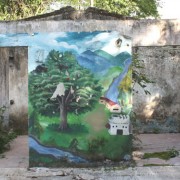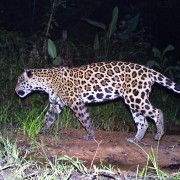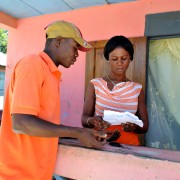By mule, it takes an entire day from the nearest paved road to reach the Kogui indigenous village of San Antonio in the Santa Marta mountain range near Colombia’s Atlantic Coast. The people here live on small farms, where they grow subsistence crops like maize, beans and sugar cane.
Out of this dispersed community of nearly 2,000 people, around 240 children attend school in San Antonio. Due to cultural beliefs, usually only one child per family leaves home to attend school. Many of them board there during the week while adults travel to the village for festivals and other communal events.
This isolation has made access to electricity a challenge. The school in San Antonio installed a micro hydroelectric power plant, which uses the flow of water from a small river or stream to produce low-cost, clean power, in May 2011. But due to incorrect installation and lack of servicing and repairs, after two years it provided an average of just five hours of power a day. According to Mother Elcida Jerez Landazabal, the Kogui representative in charge of the community school and health center, the power was unpredictable and often affected by work on dam projects in the area.
Study hours and lesson planning for teachers were often cut short by the outages. The school’s health center lacked energy for refrigeration most of the time, making it impossible to stock up on essential vaccines or anti-venom serum for snake bites, much needed in this isolated area.
Mother Landazabal said that health-care services had shrunk to the most basic level. The school’s kitchen, which served food for nearly 300 students and staff, used an old woodstove that produced large plumes of smoke and consumed a considerable amount of the scarce wood available.
In August 2012, staff from USAID’s Colombia Clean Energy Program visited the town and assessed its energy needs. As part of this program, USAID works to develop renewable energy projects in the off-grid zones that cover nearly two-thirds of Colombia’s territory. In general, the people living in these zones are marginalized due to geographic isolation, historical inequality and insecurity.
Based on an initial assessment of energy needs in San Antonio, USAID helped rehabilitate the existing micro hydro power plant, and installed additional renewable energy systems (biomass and solar) for the education and health centers. USAID also installed a water purification system and an improved wood cook stove, which significantly reduced fuel wood consumption and indoor air pollution. A fuel-wood plot of three hectares was also developed to supply fuel for the new cook stove.
According to Jesús Gómez, the project’s renewable energy expert, all of these measures were designed to help decrease the toll of deforestation in the surrounding mountains and improve health conditions at the school. USAID also provided 17 solar lamps for community school teachers to use in their homes for class preparation at night.
Wind, Sun, Water
USAID/Colombia’s renewable energy activities currently reach more than 3,500 beneficiaries living in areas that lack electricity, have outdated power sources like San Antonio, or have intermittent power from highly polluting, expensive and noisy diesel generators. At least 13,000 more community members are expected to benefit by the program’s end.
According to Chris Abrams, director of USAID/Colombia’s Environment Office, “Access to reliable, clean energy is essential for Colombia’s indigenous communities to access economic opportunities and sustain a better quality of life without sacrificing their environment.”
Indigenous communities have a strong connection to their environment. Wind, solar and water help sustain this connection, and provide power. This also helps communities live sustainably and independently, fostering cultural growth and preserving their community rights.
The clean energy program is crucial to helping the Colombian Government reach its goal of providing 30 percent of off-grid power through renewable energy sources by 2020. Today, only 8 percent of off-grid power is attributed to renewable energy sources, including small hydro and solar systems.
USAID is also working with different Colombian agencies to create regulatory and market conditions for the development of large-scale renewable or hybrid systems for bigger towns that are off the grid.
According to Gómez, USAID’s clean energy activities are tailored to use a particular area’s natural resources—wind, sun and water.
For example, the program will capitalize on solar power in the sun-drenched Guajira region with solar-powered water distillation and water pumping systems, and lamps. The lamps, each supported by a single solar panel, provide enough lighting for the one-room huts that many in the area call home.
This tailored approach helps take into account existing resources and options. For instance, rehabilitation of an existing power source can often be the quickest and most sustainable option.
Bringing Communities On Board
In spite of this careful planning, even the best-intentioned projects sometimes encounter resistance. Francisco Sauna Limaco, the first-grade teacher at the school in San Antonio, says there were some skeptics when the project came to town. Previous efforts neglected important community input and could not guarantee resources for operations and maintenance costs.
To address this issue, USAID invites community members to participate in every step of the clean energy project: They attend early roundtables on project development; sit on oversight committees during implementation; and, with training, learn to sustain the projects for the long term. This socialization process helps the community develop a sense of ownership.
In San Antonio, a trained member of the community is now responsible for maintaining the micro hydroelectric power plant and making sure the structure remains clear of any large leaves or branches that might obstruct the water flow. The plant now runs 24 hours a day.
“Our interest is to leave projects that serve as an example for others, and which also continue on for the community,” says Gómez.
At times, though, resistance has its roots in simple economics. Some of the communities that currently depend on diesel generators don’t pay the market rate for electricity and have no immediate incentive to conserve. Therefore, USAID works on changing mindsets.
“Educational awareness of the long-term benefits—financial, environmental and sustainability—is a key component of USAID’s interaction with communities,” says Igor Rodríguez, the project’s rural development specialist.
The project team meets with each family to discuss the importance of conserving electricity. And it’s more than just talk—prices for the electricity that replaces the subsidized diesel are readjusted to reflect operating costs, so villagers have a new incentive to conserve. This also provides each community’s facility with enough revenue to continue operations and ensure proper maintenance.
Public-Private ‘Win-Win’
In other communities, USAID partners with large electricity companies like EPSA (Empresa Energética del Pacífico SA) and environmental authorities like CVC (Corporacion Autonoma del Valle del Cauca) to develop renewable energy projects. Through these partnerships, USAID has initiated two projects: a solar system for a handicrafts workshop and a hydro system for an agricultural school and local homes. These two projects will benefit around 187 local residents, teachers and students.
Both parties have an interest in developing this partnership, as the electricity companies need to develop these zones anyway and the environmental authorities have a social responsibility as well as investment budgets oriented to the sustainability of the off-grid communities. And they can continue to run the projects long after USAID has gone.
“This is a win-win. Because [eventually] we leave; we need someone to take control of these. It’s necessary from the point of view of sustainability,” says Gómez.
The introduction of sustainable energy sources opens up new economic options for community members. For instance, by the Panguí River, an Embera indigenous community has traditionally laid their rice out to dry in the open. However, birds and chickens gobble up much of the grain as it dries. USAID is currently working with the community to help them invest in a solar-powered grain dryer and a mill operated with hydro power to more effectively process their grain.
“This will also help open up market opportunities for excess crops and keep more of the value from processing the rice within the community,” says Rodríguez. “Basically, we are trying to do rural development from the starting point of clean energy.”
Back in San Antonio, Limaco, the schoolteacher, says that with new lighting for classrooms, the cafeteria and boarding rooms, the community has greatly benefited. “Now I can use the solar lamp at night to prepare classes for the next day and to write my reports for the school children.” He says children also spend less time gathering wood, giving them more time to focus on their studies.












Comment
Make a general inquiry or suggest an improvement.